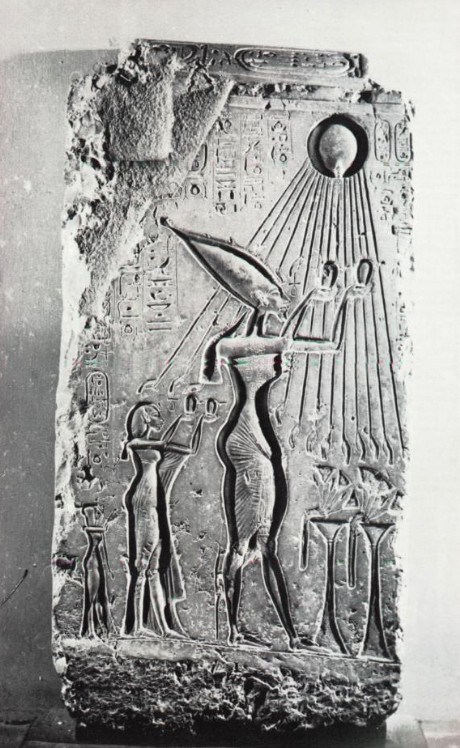

"Man and His World International Fine Arts Exhibition Expo 67 Montréal Canada" by Pierre Dupuy © the Canadian Corporation for the 1967 World Exhibition and the National Gallery of Canada
| Egyptian. Reign of Akhenaten
c. 1379-1361 B.C.
King Akhenaten and Queen Nefertiti adoring the Sun Akhenaten, the heretic king who defied the political and religious power of the Theban god Amun, is here seen in the act of worship. His god, appearing in the form of the sun's disk, was a more rational, more universal concept of the Sun than the old falcon-headed sun-god Ré, the centre of whose cult was Heliopolis in Lower Egypt. With the usual ancient Egyptian love of expressing abstract ideas by means of concrete symbols the rays of the Aten (devine sun) are shown ending in beneficial hands, some of which hold the hieroglyphic sign "life." The king is followed by his queen Nefertiti and by the eldest of their six daughters Meritaten. The king and queen carry a libation vessel in each hand while the princess holds a sistrum, a jangling instrument traditionally carried by female worshippers. All three figures wear the elaborately pleated diaphanous linen garments fashionable in the late Eighteenth Dynasty. Lotus flowers are offered on the two tall stands. This fragment, which is decorated in sunk relief (relief en creux), was part of the balustrade of a ramp in the great court of the Main Palace of the city which Akhenaten founded in the sixth year of his reign in honour of the Sun. The inscription above the king's head names "the House of Rejoicing of the Aten in the Temple of the Aten in Akhetaten," a columned pavilion discovered and identified by the excavators at the entrance to the Great Temple. The three figures reveal the exaggeration and distortion typical of the early part of Akhenaten's reign. This style is perhaps due to the desire to break with the past and to create a new art in keeping with the revolutionary ideals of the king, who denied not only Amun but also the rest of the manifold Egyptian gods, though reserving to himself the right to be worshipped as the son of the Aten. Soon after Akhenaten's death Amun's power was reestablished and Aten worship was wiped out, but Akhenaten's reign of eighteen years left a permanent mark on intellectual thought, society, literature and art. |